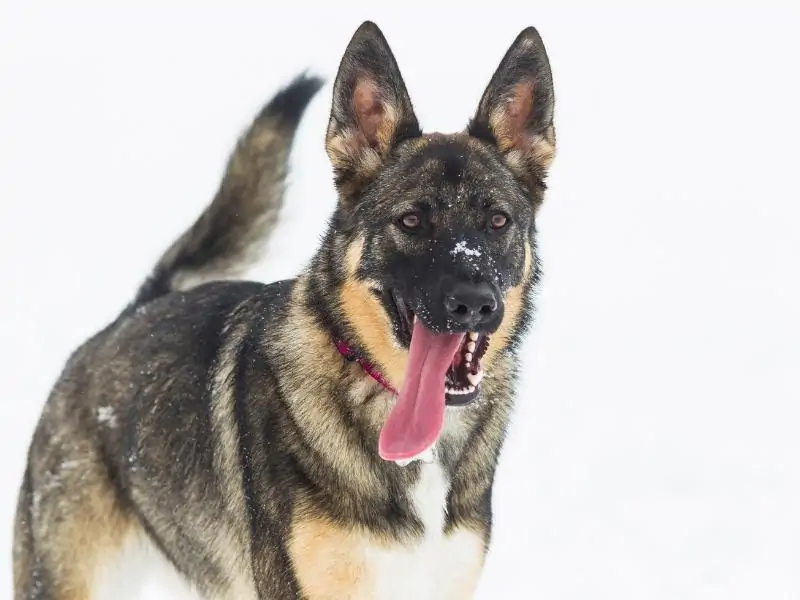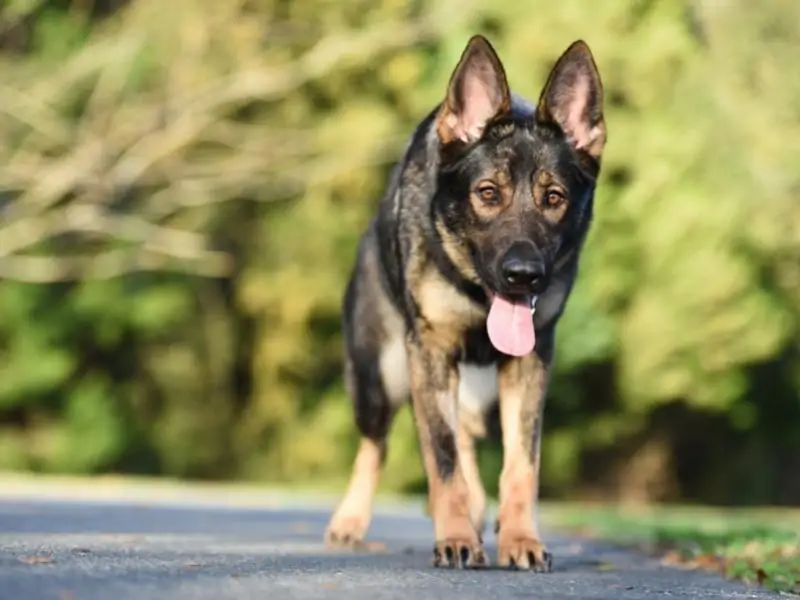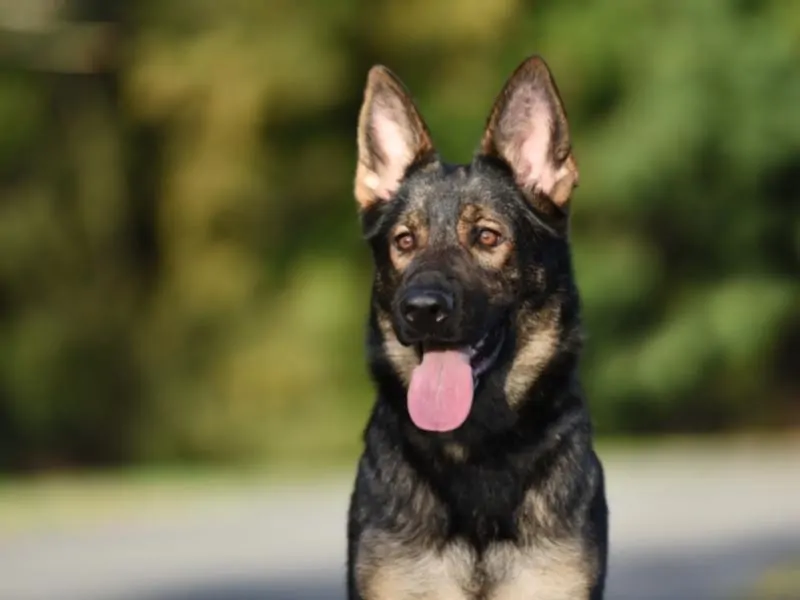Are you looking for a dog that possesses all the traits of a purebred German Shepherd but looks differently? Meet the sable German Shepherd, a recognized variety within the GSD breed.
So, are sable German Shepherds different? No, sable German Shepherds are not really different from traditional German Shepherds. The main difference between these two varieties is their coat color. Genetically, sable is the dominant coat color from the agouti genes series. A sable GSD has the same temperament and needs as any other GSD.
Read on to learn everything you need to know about these hard-working, obedient, and trainable dogs!
What Is a Sable German Shepherd?
The sable German Shepherd isn’t a mixed-breed dog. They are an officially recognized variation of the German Shepherd breed.
Sable German Shepherds are recognized by the American Kennel Club and fall under the same standard as traditional German Shepherd dogs.
Brief History of the Sable German Shepherd
The German Shepherd breed of dog was developed in Germany mainly for herding sheep. Over the years it evolved into an all-purpose working dog that is used by military and police, as well as for search and rescue and bomb detection jobs.
Max von Stephanitz is credited for developing the German Shepherd breed. In 1899 he found an ideal dog at a dog show, purchased it, and named it Horand von Grafrath.
Horand who became the center of the breeding program was in fact a sable-colored German Shepherd. He managed to sire 84 puppies and a lot of interbreeding took place to preserve the desired characteristics of the breed.
Characteristics of a Sable German Shepherd

Sable German Shepherds look pretty much the same as other German Shepherd dogs except for their coat. They have dome-shaped heads, long and square muzzles, and erect ears that give them an alert expression.
Physical Appearance
Like any other type of German Shepherd, sable-colored GSDs should give off the impression of strong, agile, and well-muscled dogs (source). The body is longer than taller and ends in a bushy tail.
Size
The German Shepherd is a large breed, and sable dogs are no different.
Height and Weight
Males are between 24 and 26 inches tall and weigh between 75 and 95 pounds. Females are smaller, and typically weigh from 55 to 75 pounds, and are between 22 and 24 inches tall at the withers.
Color
According to the breed standard, the German Shepherd dog varies in color and most colors are allowed. Sable color means the GSD has lightly colored hair with black tips which make the dog look mottled or grey.
When it comes to sable-colored German Shepherds, color combinations are more varied. The sable coat patterns can actually be any mixture of tan, black, brown, or red.
Interestingly, the term sable is used the most in the United States. In other countries, sable dogs are referred to as grey.
Coat
Sable German Shepherds have thick double coats with a coarser top layer and soft undercoat. The coat can be either medium or long in length, though most dogs have medium-length coats.
GSDs blow their dense double coats twice a year, in the spring and fall, and also shed all year round. Needless to say, this breed isn’t a good choice if you suffer from asthma or allergies.
Temperament
The color of a dog’s coat doesn’t affect its temperament, so you can expect a sable German Shepherd to exhibit all temperamental traits associated with the GSD breed.
German Shepherds are highly intelligent working dogs that thrive on having a job to do. Thanks to their innate eagerness to please they can be trained to do just about anything.
This makes them favored by military and police forces, but they also make wonderful family pets and are one of the most popular dog breeds in the US.
GSDs are naturally suspicious of strangers but aren’t usually aggressive. They need some time to warm up to new faces but once they do, they are extremely loyal.
At home with their families, German Shepherds are easy-going, affectionate, and curious companions. However, when their family is threatened they can become fiercely protective watchdogs.
One thing German Shepherds aren’t good at is staying home alone often and for longer periods of time. Without the companionship they need and proper mental stimulation, they will quickly become bored and frustrated.
An under-exercised and idle German Shepherd will likely use its pent-up energy in ways you don’t like, like digging, chewing, and barking.
When their intellectual and exercise needs are met, German Shepherds make devoted and loving companions that will always watch over your family and property.
Are There Any Health Issues with the Sable German Shepherd?
Sable German Shepherds are considered healthy, but like all other breeds, they too are prone to certain health issues.
This doesn’t mean that your dog is going to experience any health problems! Just, it’s better to be aware of any potential issues if you are considering this breed. The most common problems are:
- Hip dysplasia
- Elbow dysplasia
- Bloat
- Degenerative myelopathy
- Allergies
- Exocrine pancreatic insufficiency
German Shepherds have an average lifespan of nine to 13 years, so expect your sable GSD to fall within that range.
Sable German Shepherd Care

Sable German Shepherds have higher exercise and maintenance needs compared to many dogs. Be prepared to spend a few hours every day exercising and caring for your dog! When it comes to caring, here’s what you need to do:
Grooming
Nicknamed the German shedders, German Shepherds shed all year round and blow their coats twice a year. Meaning you’ll have your work cut out for you when it comes to grooming your sable GSD.
While there is no magical product that can stop the shedding, brushing your sable German Shepherd three to four times a week will help you stay in control of how much doggy hair ends up on your clothes and furniture.
German Shepherds tend to be clean and odorless, so you won’t have to bathe your dog often. Once every couple of months, when your dog gets dirty will suffice.
Trim their nails once a month, or when you hear them clicking against the floor. Check their ears for dirt and mites weekly and clean them as needed with a dog-safe ear cleaning solution. Keep your dog’s teeth healthy and clean by brushing them with a dog toothbrush and toothpaste.
Training
Sable German Shepherds are highly intelligent and trainable dogs that thrive on positive reinforcement and reward-based training. Bred to be obedient and eager to please, these dogs can learn anything as long as they are using verbal praise and tasty treats as rewards for their efforts.
Socialization is also an important aspect of training and should start as soon as you bring your sable German Shepherd puppy home (source). German Shepherds are naturally aloof around strangers so it’s very important to introduce your dog to as many new people, children, places, noises, situations, and pets from a young age.
This will build up your dog’s confidence and show them that not all new faces pose a threat to you and your family. Continue training and socializing your sable German Shepherd throughout their life to help them grow into a well-mannered and obedient dogs.
Exercise
Sable German Shepherds are energetic and active dogs that need around 60 to 90 minutes of intense activity every day. Ideally, this should be spread into at least two shorter exercise sessions a day.
Having said that, German Shepherd puppies need less exercise than adult dogs. A good rule to follow is that you should exercise a puppy for five minutes for every month of their age until they become an adult. Meaning, a three months old German Shepherd puppy needs only 15 minutes of exercise per day.
Besides regular activities that will physically challenge your dog, you’ll also need to provide mental stimulation.
German Shepherds are bright dogs that tend to get bored easily when their brains are not challenged. Use puzzle toys, games, and training to keep your dog mentally stimulated.
Proper Diet
An ideal diet for a sable German Shepherd should be formulated for large breed dogs with high energy. The food should be made from high-quality ingredients and have appropriate levels of protein, fat, and fiber.
Since GSDs are prone to bloat, stick to a regular feeding schedule of two meals for an adult dog and avoid free feeding. Also, make sure that there is at least an hour between your dog’s meals and exercise sessions.
Where to Get a Sable German Shepherd?
If you think that a sable German Shepherd is a perfect addition to your family, there are only two things you can dog – adopt or shop!
Sable German Shepherd Breeders
While sable German Shepherds aren’t as commonly seen as black and tan GSD they are still very popular. You shouldn’t have any trouble locating a reputable German Shepherd breeder in your area.
Spend some time researching different breeders and their references before settling for one. The next step is to schedule an appointment with the breeder to meet the puppies and the mother and check the facilities they are kept in.
Sable German Shepherd Price
Sable German Shepherd puppies on average cost from $500 to $1500. The exact price can vary and depends on a lot of factors, including the breeder, location, pedigree, and exact coat color.
Adoption
Although German Shepherds are one of the most popular dog breeds, some end up abandoned and in the care of shelters and rescue organizations across the country. If you believe that a sable German Shepherd will make a perfect addition to your family, check your local animal shelter.
Don’t forget to contact German Shepherd breed-specific rescue groups to see if they have any sable-colored GSDs for adoption.
Conclusion
The sable German Shepherd isn’t a new and rare dog breed but a recognized color variety within the German Shepherd breed. Except for the coat color, these dogs are no different than traditional German Shepherds and exhibit the same temperament traits.
A sable German Shepherd dog can make a wonderful companion to active people and families with children living in a spacious house with a fenced backyard.


0 Comments